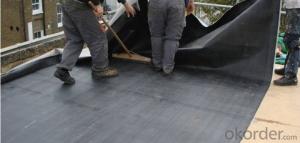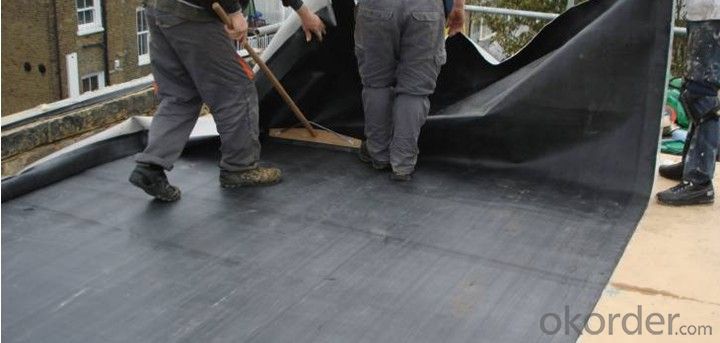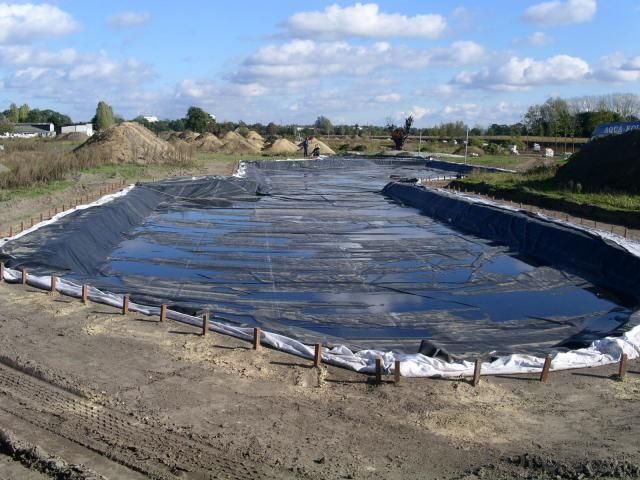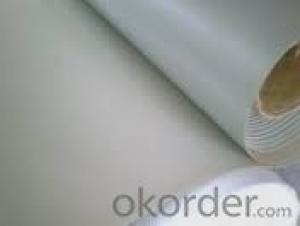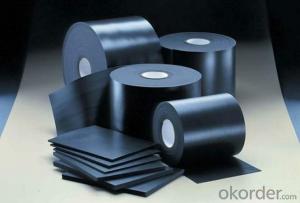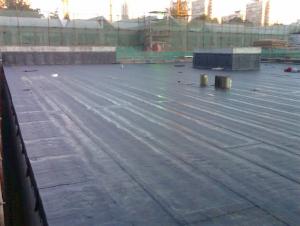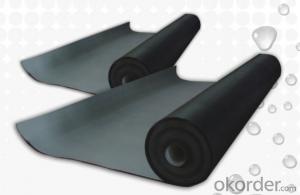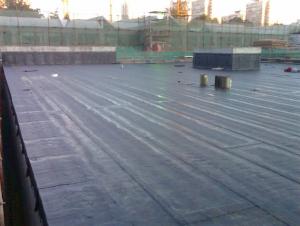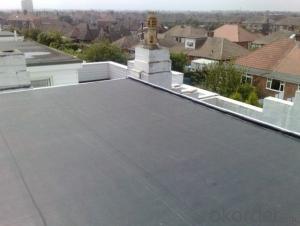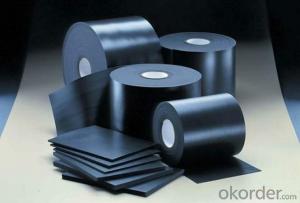EPDM Rubber Coiled Waterproof Membrane for Brick Roof
- Loading Port:
- Shanghai
- Payment Terms:
- TT OR LC
- Min Order Qty:
- 50000 m²
- Supply Capability:
- 5000000 m²/month
OKorder Service Pledge
OKorder Financial Service
You Might Also Like
EPDM Rubber Coiled Waterproof Membrane for Brick Roof
Description Of EPDM Rubber Coiled Waterproof Membrane for Brick Roof:
•EPDM waterproof sheet has excellent anti-ozone-aging performance, able to resist ultraviolet light and corrosion of many chemical corrosive materials in the atmosphere
•It has high tensile strength, high ductility and strong retractility, it has excellent crack resistance, able to effect waterproof function even with tiny vibration of buildings.
• Excellent resistance to ozone, oxidation and sunlight.
• Resistance to chemicals; resistant to most inorganic products.
Main Features of EPDM Rubber Coiled Waterproof Membrane for Brick Roof:
1>Excellent antiaging performance, service life up to 50 years
2>Working well with in 40C to 100C,it canbe constructed with a single layer in ambient temperature.
3>Waterproofing on various kinds of underground project,industrial of civil buildings and structures.
4>high extension rate, high tensile strength, small size changes at heat treatment
5>Good plant roots penetrability resistance and can be made waterproofing layer of planting roof
6>Special modified molecular structure ,effectively resolving the current domestic and foreign glue joint problem.
7>Good low temperature flexibility, and good performance of adapting to ambient temperature changes.
8>Convenient application ,solid joint, no environment pollution
9>chemical corrosion Resistance, can be used for special occasions
10>Convenient maitenance, low cost.
Specifications of EPDM Rubber Coiled Waterproof Membrane for Brick Roof:
| Material | EPDM Rubber |
| Size | 1.2m (width)*20m (length) or customized, weldable type 2.05m or 4m width |
| Thick | 1.2mm, 1.5mm, 2.0mm |
| Type | Vulcanized & Weldable |
| Pattern | Non-reinforced (homogeneous) |
| Certificate | ISO9001/14001 |
Applications of EPDM Rubber Coiled Waterproof Membrane for Brick Roof:
Widely used in roofs, basement, toilet ,swimming pool, and all kinds of industry and civil building waterproofing, reservoir, vivicism, bridge, underground, tunnel and dam waterproofing ,especially to the keystone waterproofing projects which is durability, high corrosion resistance and easy deformation.



IMages of EPDM Rubber Coiled Waterproof Membrane for Brick Roof:




FAQ of EPDM Rubber Coiled Waterproof Membrane for Brick Roof:
1. What are we supplying?
We are specialized in producing Colorful Asphalt Roof Shingle, SBS/APP modified bitumen waterproof membrane, Self adhesive bitumen waterproof membrane, PVC waterproofing membrane, EPDM rubber roofing membrane, Single Component Polyurethane Waterproof Coating, and Spray Polyurea Waterproof Coating
.
2. How Many years experience do we have?
We have been exported to more than 20 countries in the past 15 years.
3. How long do we usually reply your request?
We always reply our customer within 24 hours.
- Q: Can a waterproofing membrane be used for solar panel installations?
- Yes, a waterproofing membrane can be used for solar panel installations. Waterproofing membranes are commonly used in construction to create a watertight barrier. When properly installed, they can effectively protect the underlying structure and prevent water leakage. This makes them a suitable option for protecting solar panel installations from potential water damage.
- Q: Are waterproofing membranes suitable for crawl spaces?
- Indeed, crawl spaces can be susceptible to moisture and water infiltration due to their positioning and inadequate ventilation. However, by implementing waterproofing membranes, one can effectively thwart water damage and issues arising from excessive moisture. These membranes are specifically engineered to establish a barricade against water and moisture, thereby preventing their intrusion into the crawl space and the subsequent development of problems like mold growth, decay, and structural deterioration. Moreover, the utilization of waterproofing membranes can contribute to enhancing the quality of indoor air by diminishing humidity levels in the crawl space. Consequently, it is strongly advised to employ waterproofing membranes in crawl spaces in order to guarantee a dry, sanitary, and healthful environment.
- Q: Can a waterproofing membrane be used on stone block surfaces?
- Stone block surfaces can indeed benefit from the use of a waterproofing membrane. This particular membrane is specifically designed to create a protective barrier against water and moisture, making it suitable for application on various surfaces, including stone blocks. By acting as a barrier, this membrane effectively prevents water from seeping into the stone and causing detrimental effects such as cracking, spalling, or efflorescence. It offers valuable protection against water-related issues such as freeze-thaw damage and the growth of mold and mildew. Moreover, the application of a waterproofing membrane can significantly enhance the durability and longevity of stone blocks by shielding them from water damage. Consequently, it is highly recommended to utilize a waterproofing membrane on stone block surfaces to ensure their long-term integrity and aesthetics.
- Q: Can a waterproofing membrane be used in high-traffic areas, such as decks or balconies?
- Indeed, high-traffic areas such as decks or balconies can benefit from the utilization of a waterproofing membrane. These membranes are specifically engineered to act as a protective barrier against water and moisture, which makes them an optimal choice for areas that are frequently exposed to the elements. Due to their durability and ability to withstand foot traffic, they are well-suited for high-traffic regions. Decks and balconies, in particular, often employ these membranes in order to prevent water damage to the underlying structure and ensure the long-term structural integrity of the area. Moreover, certain waterproofing membranes are intentionally designed to be slip-resistant, thereby enhancing safety in high-traffic situations. In general, incorporating a waterproofing membrane into high-traffic areas serves as an effective method to safeguard and prolong the lifespan of these surfaces, while simultaneously preserving their functionality and aesthetics.
- Q: How does a waterproofing membrane handle water pressure from adjacent structures?
- A waterproofing membrane is designed to handle water pressure from adjacent structures by acting as a barrier that prevents water from seeping through. It resists the force exerted by the water pressure and ensures that no water can penetrate into the protected area.
- Q: Can waterproofing membranes be applied in cold weather?
- Yes, waterproofing membranes can be applied in cold weather. However, it is important to ensure that the manufacturer's instructions are followed regarding temperature limitations and proper installation techniques. Cold weather may affect the curing and adhesion process, so additional precautions and proper heating or insulation methods may be necessary during the application.
- Q: Can a waterproofing membrane be used in high-rise buildings?
- Yes, a waterproofing membrane can be used in high-rise buildings. In fact, it is highly recommended to incorporate a waterproofing system in high-rise buildings to protect them from the damaging effects of water infiltration. Waterproofing membranes are designed to provide a barrier against water ingress, preventing leaks and moisture damage to the structure. They are commonly used on roofs, basements, foundations, and other areas that are exposed to water or moisture. The selection of the appropriate waterproofing membrane will depend on various factors such as the specific building design, construction materials, and environmental conditions. It is important to consult with experienced waterproofing professionals to determine the most suitable membrane system for a high-rise building to ensure long-term protection against water-related issues.
- Q: Can a waterproofing membrane be used in geotechnical applications?
- Yes, a waterproofing membrane can be used in geotechnical applications. Waterproofing membranes are commonly used to prevent the infiltration of water into structures and are applied to various surfaces such as roofs, basements, and foundations. In geotechnical applications, these membranes can be utilized to prevent water from seeping into soil, preventing erosion, and stabilizing slopes. They can be installed horizontally or vertically to create a barrier that prevents water penetration, which can be particularly useful in retaining walls, embankments, and dams. Additionally, waterproofing membranes can also be used to control the flow of water and improve drainage in geotechnical projects. Overall, the use of a waterproofing membrane in geotechnical applications can enhance the durability and performance of structures while protecting against water-related issues.
- Q: Can a waterproofing membrane be used for bridge or tunnel waterproofing?
- Yes, a waterproofing membrane can be used for bridge or tunnel waterproofing. Waterproofing membranes are commonly used in construction projects to prevent water penetration and protect structures from potential damage caused by moisture. In the case of bridges and tunnels, which are exposed to harsh environmental conditions and high water pressure, a high-quality waterproofing membrane can effectively provide an impermeable barrier, ensuring the long-term durability and structural integrity of these infrastructure elements.
- Q: Can waterproofing membranes be used on buried pipelines?
- Buried pipelines can benefit from the use of waterproofing membranes. These membranes are specifically designed to shield against water and moisture, and can be applied to a variety of surfaces, including buried pipelines. Typically, these membranes are constructed from materials like bitumen or synthetic polymers, which possess resistance to water penetration. When employed on buried pipelines, waterproofing membranes serve to prevent water infiltration, a process that can lead to corrosion and material deterioration. Acting as a barrier, they effectively halt water from reaching the surface of the pipeline, safeguarding it from potential moisture-induced harm. Furthermore, waterproofing membranes also offer protection against external elements like soil chemicals or gases, which may pose threats to the pipeline. By establishing a waterproof barrier, these membranes effectively extend the lifespan of buried pipelines, diminish maintenance expenses, and enhance overall performance. It is important to emphasize that the selection and application of waterproofing membranes should be entrusted to professionals who possess extensive knowledge in pipeline construction and waterproofing systems. Ensuring the effectiveness of these membranes requires proper installation techniques and compatibility with the pipeline material.
Send your message to us
EPDM Rubber Coiled Waterproof Membrane for Brick Roof
- Loading Port:
- Shanghai
- Payment Terms:
- TT OR LC
- Min Order Qty:
- 50000 m²
- Supply Capability:
- 5000000 m²/month
OKorder Service Pledge
OKorder Financial Service
Similar products
Hot products
Hot Searches
Related keywords
